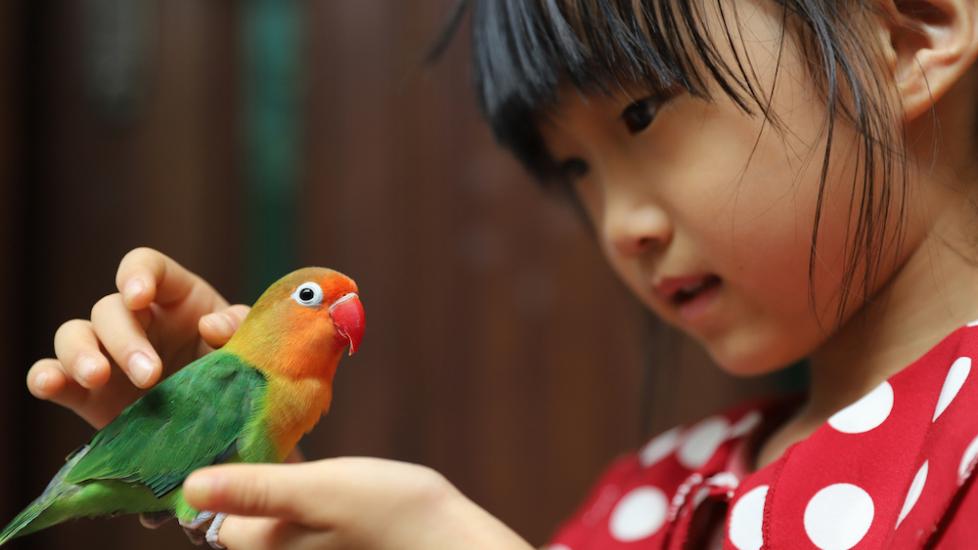7 Best Pet Bird Species
There are so many species to choose from – how do you know what is best for your family? Read on to learn a little bit about these feathered friends, and what you need to know before adopting one.
Pet Bird Species
Birds differ remarkably across species—not only how they look, but also by the level of care they require and their personalities. Some birds may be an ideal fit for your family, while others aren’t a realistic option for your lifestyle. Keep in mind that these are generalities—and each bird is an individual—but the information below might help you to get started on your search for the ideal feathered friend for your life.
Budgerigar
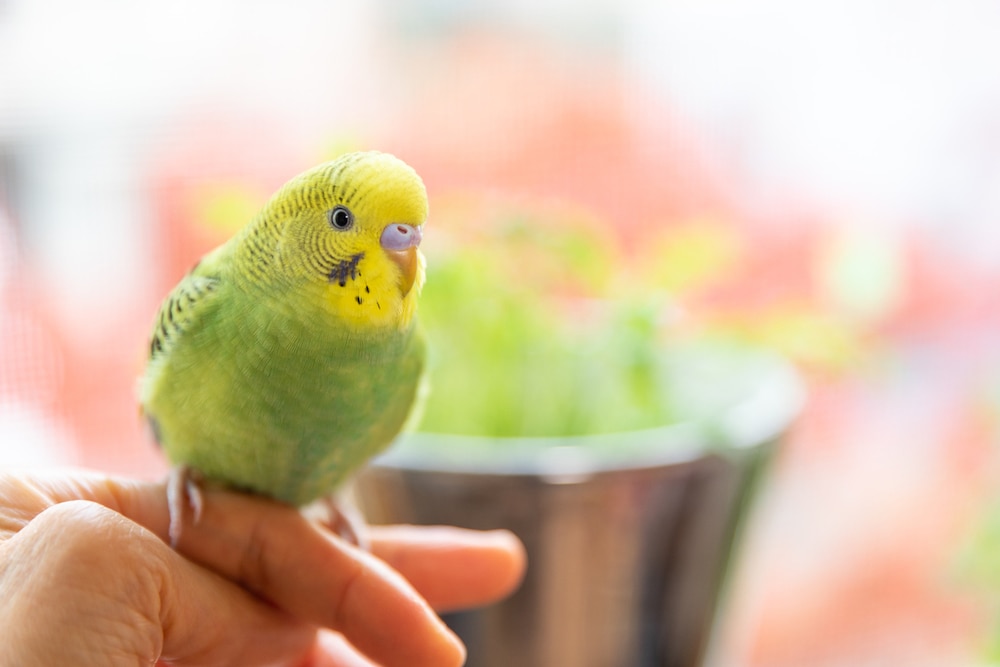
Also called a budgie or parakeet, these colorful, social little parakeets are often the first bird adopted by families, particularly those with children. Budgies tend to love attention, and they tame quickly when handled regularly and consistently. They are not as noisy as some of the other popular bird species, but do develop a vocabulary of whistles, sounds, and even words.
Although all birds can bite, with regular handling, most budgies will become quite gentle. Like all birds, however, they can be messy and will need daily care, attention, feeding, and cleaning.
Budgies are very small birds, which can make them easy targets for other household pets like dogs and cats. Although they are petite, budgies do need a large cage with plenty of interesting toys to explore. Budgies often thrive if allowed “free time” in the house out of the cage with family but are also one of the species who can be content to stay in their cage. Just be sure they get social time through the bars and the cage is large enough to provide them with amusement.
Lovebirds
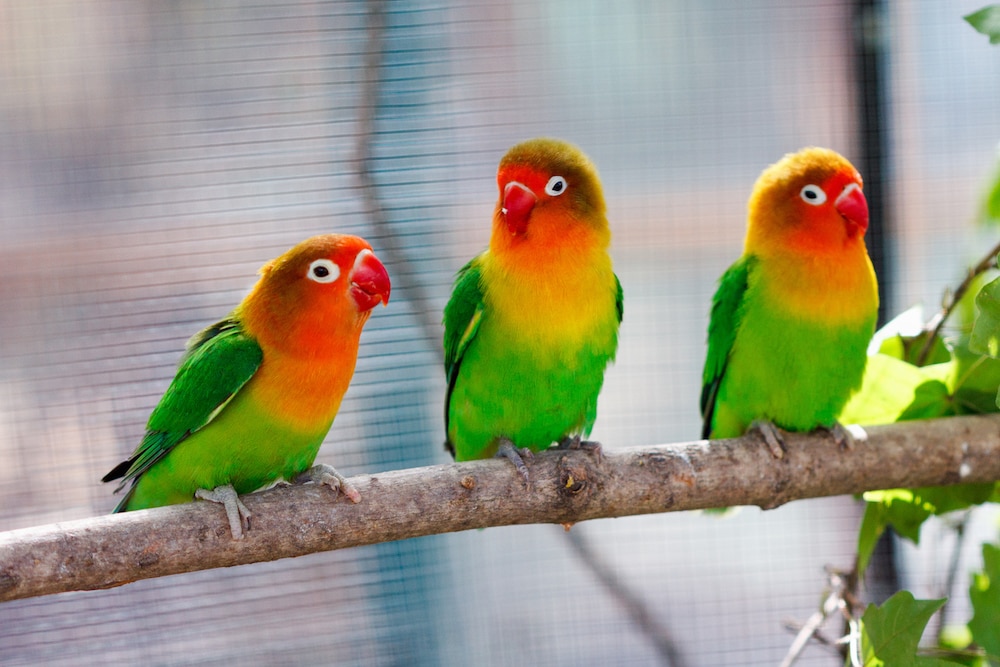
Lovebirds are one of the smaller members of the parrot family, which are often common “starter” birds for new bird parents. Many people associate lovebirds as coming in pairs, since they are often seen in photographs snuggled up to a companion. It is certainly appropriate to get a pair of birds—but in this case, the birds may choose to socialize with each other, rather than the human family. For this reason, many people choose to own a single lovebird. However, if this is the case, a lone lovebird will need a lot of consistent attention and socialization.
Lovebirds, like all parrots, tend to be a little strong willed about their desires, and make their wants and needs clearly known. This can sometimes be accompanied by a firm nip, meaning that significant time needs to be invested in social interaction and training with any members of the parrot family, lovebirds included.
Lovebirds are comical, colorful, entertaining birds that are highly intelligent and learn tricks and games quickly. Many birds develop a wide repertoire of sounds and words and enjoy learning new vocal skills. Some lovebirds can be rowdy, meaning that they may not be an ideal choice in apartment-type households or in homes where people need to sleep during the day. They thrive with plenty of social out-of-cage interactions–typically daily.
Cockatiels
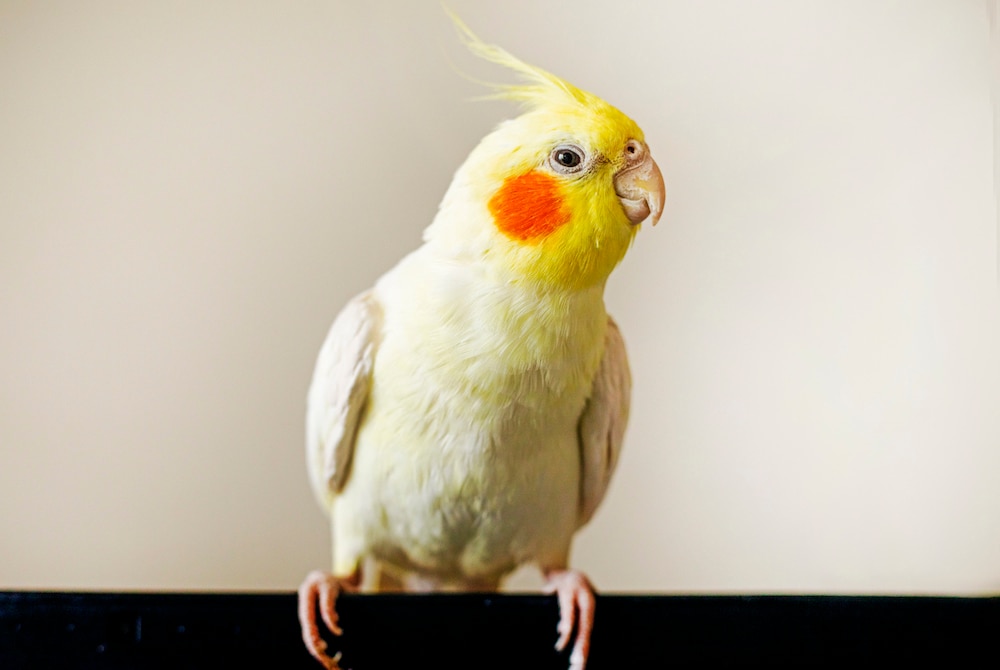
Cockatiels are a slightly larger bird than either the parakeet or the lovebird.. They are extremely popular pets, and with good reason. Social and curious, cockatiels love to play with toys and entertain with whistles and chirps. Although they don’t typically have a large word vocabulary, they will often “talk” back and forth with owners in their own language of sounds and body language. The position of the crest of feathers on top of their head can also help you to tell their mood—from straight up when alert to folded back when stressed.
Cockatiels are often content to spend significant amounts of time in a large cage if they get interactive attention. However, they are also often good household citizens when allowed to spend social time loose in the house. Take care to protect them against other household pets as well as fans, open doors and windows, and hot food on the stove.
Doves
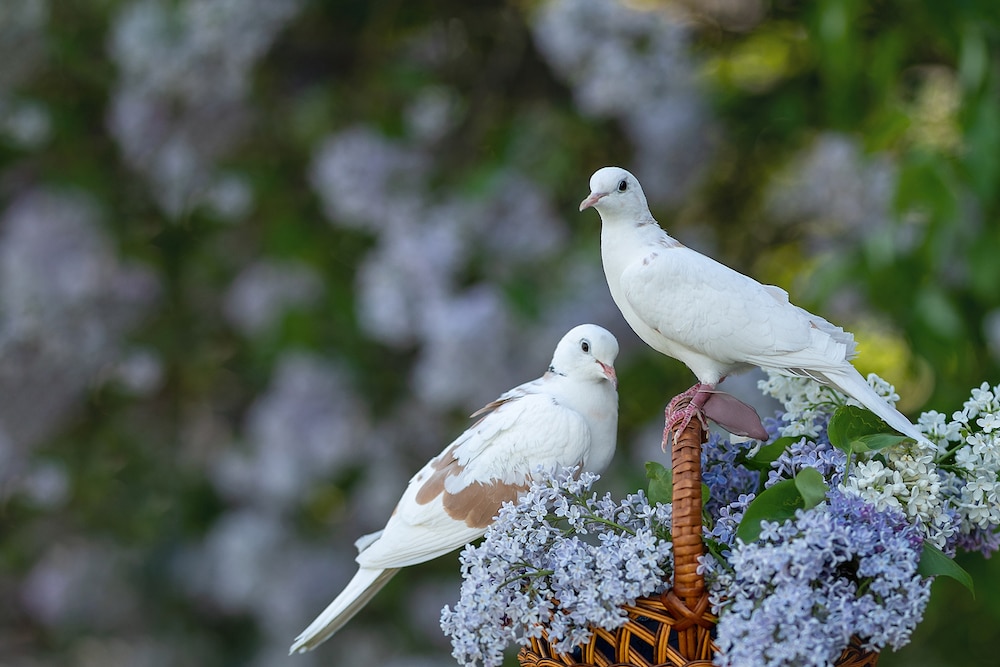
Doves are ideal pets for those that would like a “hands off” bird. Although very appreciative of social interactions, doves are quickly made nervous with excessive handling. Some can be hand trained, but most would like to interact at a distance and on their own terms.
Doves are quieter than the parrot family birds and are likely to limit their sounds to a gentle cooing noise. Doves are social with people, but especially with others of their own kind, and watching their interactions with each other can be fun. And, since they don’t have the powerful beaks associated with the parrots, their nips are less severe.
Conures

Conures are small to medium parrots who thrive on continual interaction with their families. They are highly intelligent and curious, and always want to be part of the action. They prefer to be on or with their people whenever possible—this might even mean “hiding” under your shirt during snuggle time.
Conures tend to be playful, bold, and outgoing. They also have a strong bill which can deliver a firm bite. Some conures also tend to be loud—as in extremely loud. These birds are not suitable for life in close quarters, or for those with a low tolerance for noise. They are relatively high maintenance pets but reward their families with years of loyalty and entertainment.
African Grey Parrots
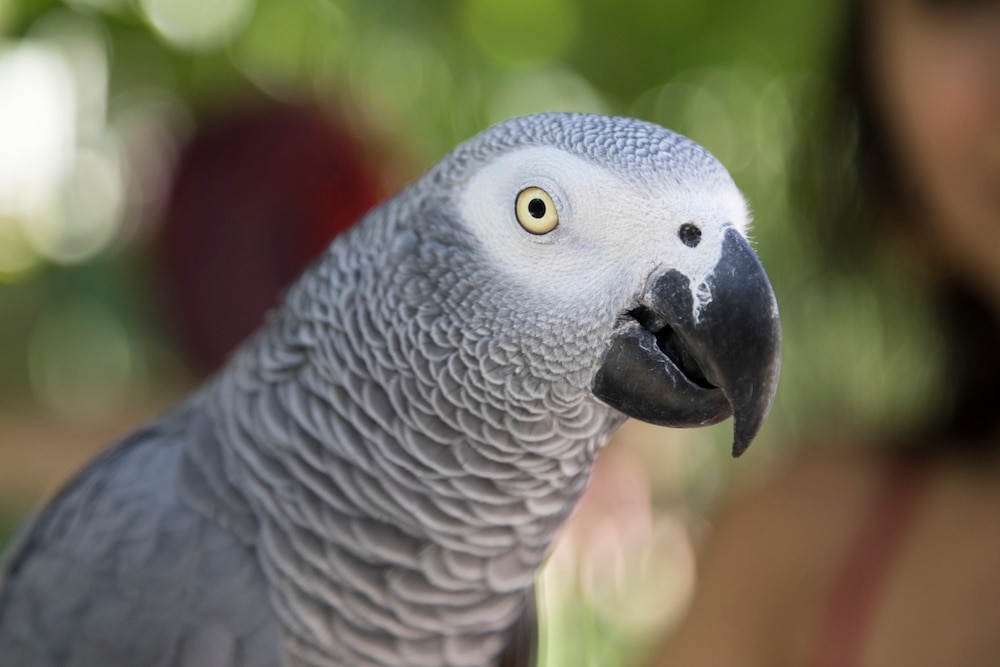
These birds are medium sized parrots known for their talking and sound making ability. They are both sensitive and intelligent which can easily lead to behavior problems. These birds, known as the “Einsteins of the Bird World” are best kept by experienced bird enthusiasts with the time, energy, and budget to provide for their needs. They are social, but are not cuddly birds. They are experts at destroying toys meant for them, as well as things such as household woodwork.
African grey parrots tend to be creatures of habit, and don’t thrive with changes in their habits or environment and can often become one-person birds, even when regularly handled by multiple people in a household. They are prone to several medical and behavioral problems, which can be time consuming and expensive. But for their chosen people, these can be delightful pets capable of interactive conversations that are unparalleled by other birds.
Cockatoos

Cockatoos are medium sized parrots which have well-earned the nicknames of “Velcro birds” because of their need for constant attention from their owners. These birds are extremely affectionate and often have an obsessive need to be with their owners—and not just in the same room, rather to be physically with their humans. They can be very vocal and make their displeasure known from across the house. However, they are also very intelligent as well as emotional.
Many that have lived with cockatoos describe it just like living with a two-year-old child that never grows up; these birds are capable of swinging from a total temper tantrum to absolute silliness in the blink of an eye. Cockatoos have a 30+ year lifespan, meaning that pet parents need to be prepared to have a long-term commitment with these needy feathered friends.
Shop Bird Products
- Mazuri Small Bird Food, 2.5-lb bag$13.59Chewy Price
- JW Pet Small Comfy Bird Perch, 21-in$6.30Chewy Price
- Lafeber Tropical Fruit Nutri-Berries Cockatiel, Parakeet & Lovebird Bird Food, 10-oz bag$11.99Chewy Price
- SunGrow Parrot Large Climbing & Cage Hammock Swing Foraging Net & Activity Play Bird & Small-Pet Chew Mat$12.91Chewy Price
What Is the Best Bird To Get as a Pet?
The “best bird” will depend on your family lifestyle. All birds will require daily attention, feeding, and cleaning, as well as a commitment to “bird proofing” both your house and your lifestyle. How much time and effort you are able to commit to your new feathered companion should help guide your choice of a bird.
What Is the Easiest Pet Bird to Tame?
Taming a bird will depend somewhat on the bird’s background. Young birds, as a rule, are easier to tame than older birds. Those that have been hand reared will invariably be easier to work with than those that are not, meaning birds purchased through pet store bird mills are likely to be much harder to handle. Meeting a bird through a bird shelter or rescue should help you determine how their level of tameness and their personality.
What Is the Gentlest Pet Bird?
The most gentle pet bird is the one that you started working with at a young age and consistently worked with and tamed. All birds are capable of biting, and the bills of the parrots in particular can deliver a very firm bite; even the smaller parrots can provide a very painful bite. Working and playing with your bird every day is the most reliable way to make your bird gentle.
What Pet Bird is Low Maintenance?
Birds, on average, are not low-maintenance pets. Despite the fact that bird stores sell bags of “birdseed” for the vast majority of species, this is not an appropriate diet. Purchasing and feeding the appropriate food for your species of bird, buying an appropriate cage and toys, keeping things clean, and spending social time all adds up to significantly more time and expense than that required by an average cat or dog.
Birds also require specialized veterinary care, meaning that your corner veterinarian is unlikely to be comfortable working with them and that you may need to travel for the birds’ medical needs. Many of the pet bird species also have a life expectancy of more than 20 years. This all translates to the fact that the decision to getting a pet bird is a significant investment of time and money. Some of the shorter lived and cage content species are likely to be considered the “lowest maintenance,” so owners looking for an avian companion that requires care on the level of a dog or cat might want to consider something along the lines of a budgie, cockatiel, or dove.
What Is the Most Loyal Pet Bird?
Generally, the most loyal pet bird is the one you have spent time, energy, and love hand taming! Although birds may ultimately choose their “person”, all birds respond positively to gentle handling and positive reinforcement.
Featured Image: iStock.com/Gins Wang
